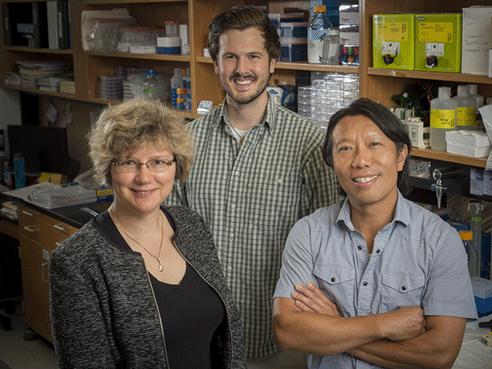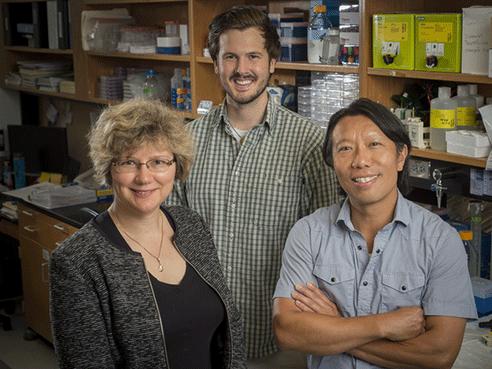
BIRMINGHAM, Ala. – University of Alabama at Birmingham researchers are exploring ways to wrap pig tissue with a protective coating to ultimately fight diabetes in humans. The nano-thin bilayers of protective material are meant to deter or prevent immune rejection.
The ultimate goal: transplant insulin-producing cell-clusters from pigs into humans to treat Type 1 diabetes.
In preclinical work begun this year, these stealth insulin-producers — pancreatic islets from pigs or mice coated with thin bilayers of biomimetic material — are being tested in vivo in a mouse model of diabetes, say UAB investigators Hubert Tse, Ph.D., and Eugenia Kharlampieva, Ph.D. Tse is an immunologist and associate professor in the Department of Microbiology, UAB School of Medicine, and Kharlampieva is a polymer and materials chemist and associate professor in the Department of Chemistry, UAB College of Arts and Sciences.
Their research, supported by two new JDRF Diabetes Foundation grants, “is a nice example of a truly multidisciplinary project that encompasses distinct areas of expertise including engineering, nanomaterials, immunology and islet transplantation,” said Fran Lund, Ph.D., professor and chair of Microbiology at UAB. “The project also melds basic science and engineering with the goal of developing better treatments for diabetes.”
“Our collaboration works because we have the same mindset,” Kharlampieva said of her collaboration with Tse. “We want to do good science.”
One of the chief jobs of pancreatic islets is production of insulin to regulate levels of blood sugar. In Type 1 diabetes, the β-cells that produce insulin are destroyed by an autoimmune attack by the body’s own immune system. To protect transplanted donor islets, researchers elsewhere have tried to coat islets with thick gels, or with coatings that bind covalently or ionically to the islets. Those approaches have had limited success.
Tse and Kharlampieva have taken a different approach, applying a gentler and much thinner coating of just five bilayers of biomimetic material about 30 nanometers thick. These layers act as a physical barrier that dissipates reactive oxygen species, and they also dampen the immune response. The thinness of the coat allows nutrients and oxygen easy passage to the cells.
“We did not expect the multilayers would show such a large, potential benefit,” Kharlampieva said of the immunomodulation shown by the bilayers.
The Tse-Kharlampieva collaboration got its start out of efforts to solve a problem in a UAB service to provide islets to national researchers — the islets often died or stopped secreting insulin during the three to five days of shipping. Kharlampieva was asked whether her bilayers might somehow protect the islets and preserve viability and functionality.
The bilayers are held together by hydrogen bonding, through an attraction between polar groups in the layers, which Kharlampieva calls a “friendlier approach” than covalent or ionic bonds. One of the layers, tannic acid, is a polyphenol that can scavenge destructive free radicals, much like the polyphenols found in green tea. Tse — who studies how oxidative stress contributes to islet dysfunction and autoimmune responses in Type 1 diabetes — wondered whether tannic acid’s ability to defuse radical oxygen species might help to lessen autoimmune dysregulation.
In collaborative research over more than five years, the UAB researchers showed that the answer was yes.
In a 2012 Advanced Functional Materials paper, Tse, Kharlampieva and colleagues found that:
- The bilayers, which include tannic acid, were able to wrap smoothly around a variety of mammalian pancreatic islets, and they maintained high chemical stability
- The coated islets retained viability and β-cell function in vitro for at least 96 hours
- Hollow shells of the bilayers suppressed synthesis of the proinflammatory cytokines IL12-p70 by stimulated macrophages and interferon- γ by stimulated T cells
In a 2014 Advanced Healthcare Materials paper, the researchers further examined the immunomodulatory effect of the hydrogen-bonded multilayers, in the form of hollow shells. They showed that the bilayer shells have:
- Antioxidant properties, as demonstrated by the dissipation of proinflammatory reactive oxygen and nitrogen species
- Immunosuppressive properties, as demonstrated by attenuated production of proinflammatory cytokines interferon-γ and tumor necrosis factor-α by antigen-stimulated autoreactive CD4+ T cells
The next step for the UAB researchers is in vivo testing of xeno- and allotransplantation to see if the bilayer-coated pancreatic islets have decreased risk of graft rejection, while restoring control of blood sugar. Xenotransplantation is transplanting from one species to another, and allotransplantation is transplanting from one member of a species to a different member of the same species.
In a one-year, in vivo demonstration grant, the UAB researchers found that nano-coated mouse islets survived and functioned as long as 40 days in diabetic mice that lack working immune systems. “We showed that they do stay alive, and they function to regulate blood glucose,” Tse said.
Now Tse and Kharlampieva, supported by two new JDRF grants, are testing the survival and functioning of nano-coated islets from mice or pigs in diabetic mice with intact immune systems.
The pig islets come from their University of Alberta collaborator Greg Korbutt, Ph.D. Korbutt’s team in Edmonton, Canada, has shown that human islets transplanted into immunosuppressed patients with brittle diabetes can produce insulin independence. “They are the leader in islet transplantation and developed the Edmonton Protocol for novel immunosuppression,” Tse said.
Pig islets — in contrast to scarce supplies of human islets — offer an unlimited source of insulin-producing tissue.
In the UAB experiments, the mouse and pig islets are coated with four or five bilayers of tannic acid and either poly(N-vinylpyrrolidone) or poly(N-vinylcaprolactam) by UAB research scientist Veronika Kozlovskaya, Ph.D. Mouse islet collection and transplantation of mouse or pig islets into mice is performed by UAB research technician Michael Zeiger, who grew up in Indonesia learning surgical skills from his veterinarian father.
###
At UAB, Lund holds the Charles H. McCauley Chair of Microbiology.
Media Contact
Jeff Hansen
[email protected]
205-975-3914
http://www.uab.edu
The post Stealth pig cells may hold the key to treating diabetes in humans appeared first on Scienmag.





